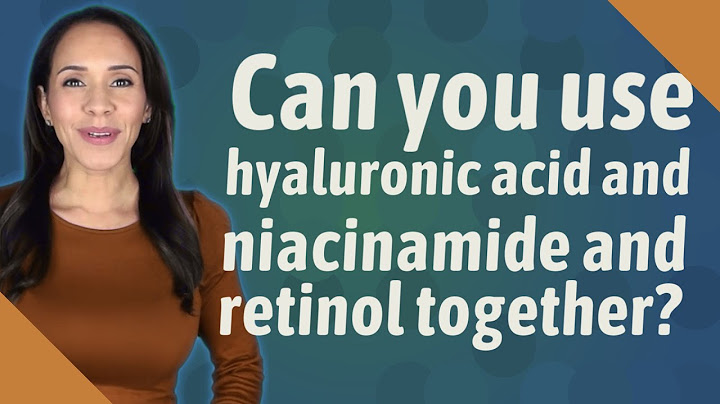While researching and refining your skincare routine, you’re likely to have come across niacinamide and hyaluronic acid. They both feature in a lot of popular products, though knowing the exact differences between hyaluronic acid vs niacinamide is important before you add one or both ingredients to your regime. Show
Although they’re both versatile skincare fan favorites, both ingredients serve different purposes for skin. You're probably already aware that adding one of the best hyaluronic acid serums is a reliable way to inject some hydration into thirsty skin. “Hyaluronic acid is a sugar and niacinamide is a vitamin, so they’re all fundamentally different kinds of ingredients that do different things for us,” says Dr. Nathan Brown, chief science officer at Parallel Health. On that note, let’s dig deeper into the uses, benefits, and differences of these unique ingredients. Meet the experts on ingredients like hyaluronic acid and niacinamide
(Image credit: Getty Images) Hyaluronic acid: the ultimate hydrating agentFirst up is hyaluronic acid, a polysaccharide that’s naturally found in our bodies, from the skin to the eyes, joints, and connective tissues. As a skincare ingredient specifically, though, it’s best known for helping the skin retain moisture and for making dull or dry complexions look and feel smoother and plumper. One of the key benefits is that it's easy to use at home in the form of topical gels, serums, or masks—Our The Ordinary Hyaluronic Acid Serum review is a great in-depth analysis of a nice and affordable option on the market. Fun fact: this ingredient is actually also used in dermal fillers. “The long, stringy sugar molecule absorbs water to form a gel that is useful for hydrating the epidermis, the outer layer of skin that we see in the mirror, and providing structure when injected into the dermis, the skin layer just beneath our epidermis,” says Dr. Brown. “Niacinamide can’t help hydrate our skin like hyaluronic acid.” Skin and wellness expert Marie Reynolds adds that hyaluronic acid ”can hold up to 1,000 times its molecular weight.” It’s a no-nonsense humectant that soaks up moisture and keeps it there, resulting in a more hydrated and youthful complexion. What are the benefits of hyaluronic acid?
Niacinamide: the jack-of-all-trades vitaminNow, onto niacinamide. This ingredient offers plenty of sweet skincare benefits, but it’s not a sugar like hyaluronic acid. “Niacinamide is one of the B vitamins, specifically a form of vitamin B3,” says Dr Brown. “Vitamins are molecules that our bodies cannot produce by themselves and must be received through nutrition or topical application.” (Image credit: Getty Images) While hyaluronic acid is a skincare specialist in hydration, niacinamide has a pretty extensive resume. “It is your vitamin B3, jack-of-all-trades active ingredient that’s found to help with fortifying your skin barrier, regulating excess sebum for oily skin, and even brightening and evening skin tone,” according to authors of Skincare Decoded, Victoria Fu and Gloria Lu. The two skincare chemists tell us it’s an easy ingredient to formulate with, so the people who develop products love working with it. Dr. Brown adds that its versatility has helped it earn the position as “one of the hottest skincare ingredients” on the market today. What are the benefits of niacinamide?
However, as with many powerful actives like the best vitamin C serums, it's important not to overuse niacinamide. “Less is always more,” Marie says, noting that using too much could lead to adverse reactions. And those words of wisdom apply to the frequency of use as well as the concentration of niacinamide in the serum or moisturizer you’re using. Victoria and Gloria recommend “checking out the ingredient lists of the product in your routine to make sure you’re not overdoing this active ingredient—2% to 5% is the sweet spot. Try not to exceed 10%.” How to add hyaluronic acid and niacinamide to your skincare routineGood news! Both of these ingredients can be used at either time of day, so they're very flexible in your routine. That said, niacinamide is considered particularly beneficial in the morning because of its antioxidant properties, which mean it can protect your skin against some environmental effects. When it comes to using them in the correct skincare routine order, an oft-touted rule of thumb is that products are best applied from thinnest to thickest consistency. So, bear this in mind when deciding which to apply first in your routine if you are using both in serum form. What's clear is that weighing up hyaluronic acid vs niacinamide is a bit like comparing apples to oranges—as is hyaluronic acid vs retinol or hyaluronic acid vs glycolic acid. These two ingredients are heavy-hitters in the skincare world, but they don’t work against each other. Instead, they can partner together to help you achieve more healthy, radiant, and youthful skin if you sequence them into your routine properly. My Imperfect Life thanks Dr. Nathan Brown of Parallel Health, Marie Reynolds of Marie Reynolds London, and Victoria Fu and Gloria Lu of Chemist Confessions for their time and expertise Aleesha is deputy editor and beauty & fashion lead for My Imperfect Life, where she heads up the beauty, fashion and eCommerce pages. Previously she was shopping writer for woman&home and gained an AOP awards nomination after working on their news team. She earned an MA in Magazine Journalism from City, University of London in 2017 and has since worked with a number of brands including, Women's Health, Stylist and Goodto. When she’s not testing new products, Aleesha spends her time soaking up the newest bestsellers and Netflix releases, learning about different wines, attempting new languages and travelling as much as she can. |

Advertising
LATEST NEWS
Advertising
Populer
Advertising
About

Copyright © 2024 boxhoidap Inc.










